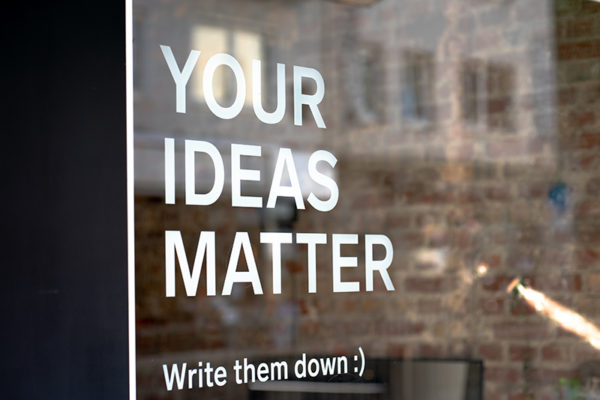Career & Entrepreneurship
The Design Process – Dos and Don’ts – Part 2
If you missed Part 1, please click here.
The difference between feedback and opinions
In the big leagues when a big brand is about to launch their new branding, they get feedback. They spend millions when launching a new brand and a lot is at stake, so they don’t take risks. This is no different for a small business owner. They may not be spending millions. but it is still a huge expense to them, and they may fear what the consequences might be on their business. The big brands will arrange focus groups, based on the demographics specifically relevant to their product and get purposeful feedback that will directly impact their profits.
Small businesses, sure get feedback, but get it from your client base or at the very least friends or associates who understand your business plan as well as you, and your long-term vision for your business. You don’t want your friends to like your branding, you want it to appeal to your specific market who will spend their money on your product. That’s who you need to share it with. So give some real thought as to who you ask, be strategic. In addition, avoid at all costs posting your ‘draft’ logo ideas from your designer on social media and ask for feedback from anyone who sees it. I see this a lot. How will this help? Personal opinions are merely that. Unless of course everyone in that thread got the same brief as the designer and understands your business strategy and the application requirements of that logo. Asking uninformed people can risk taking your branding in the wrong direction. I have not had a client who has done this with one of my logo ideas, but I sympathise with the designers who have. So, a gentle reminder, you do not want people to think your logo is nice, you want it to appeal to the people who will spend money on your product, ensure that it will sit comfortably within your sector and stand out from your competitors. This comes from research and then targeted and informed feedback. Which comes to my next very important point.
Don’t be a copycat
I see this quite often with clients and I think it’s an important topic to address, before you start talking to a designer. Your individuality as a brand will always be your USP. So, strive to stand out.
When working with clients I tend to ask them to send me reference of brands that are their direct competitors, particularly if I am not so familiar with their business sector. In general, you do not want a brand style that looks like someone else who offers the same product as you. By doing this you are telling your potential clients and/or customers to compare you with the other brand. Why would you want to do that? You fear they will, but don’t hand it to them on a plate. You want to avoid the comparison and one of the easiest ways to do that is create a brand that is entirely different. It will then as a consequence say something distinct, have a fresh tone of voice and hopefully be the one they choose.
It’s not usual for designers to be faced with clients who from the get go want their website to look like an existing brand because they saw a site, think it’s cool and want it just like that! This actually happens more often than you may think. For sure it can steer us in the direction of your personal tastes and closer to something you may like, but to replicate styles or colours, specifically those of competitors is a sign of weakness and lack of confidence. Plus, your business may have practical requirements that will not be met with the look you want to replicate. If you feel your product is better, then say so through your brand identity, not theirs.

Scott Graham on www.unsplash.com
Communication & get stuck in!
Last but not least, communicate with your designer. There is a misconception that a designer who offers 10 logo ideas is giving you value for money. Think again. I find a lot of clients assume that a designer gives multiple ideas, expects you to pick one of them, and then the job is done. If you are working with a professional, you don’t need 10 ideas you just need to communicate better. Take one or two ideas and develop one of them together as a team. Do not be afraid to tell your designer you don’t like it, but think about constructive feedback that will steer them in the direction of something better. ‘I don’t like it’ is never a problem, but a reason for that feeling helps direct us to what you do like. Be specific.
Expect to give up some time for various rounds of changes as we want to ensure every detail is met with your approval, and as much as we like the freedom to come up with a creative solution, your feedback is priceless and matters. This is how our ideas and skills can transform into something that is a perfect fit for you and your business. So, expect to give up some of your time, not just your money.
I hope you have gained some tips on how to work with your designer in order to make amazing branding together. I have worked in Brand development and design for over 15 years. Now working as a consultant and designer and finding that balance between working for large enterprises and helping smaller businesses with their branding. If you are unsure about how to take the next step with your business branding, feel free to get in touch. I am always happy to chat and provide free and impartial feedback that can give you some direction and ideas on how you can grow and strengthen your branding in the future.
About the Author:
Hayley Milne Payne is a passionate, classically-trained Graphic Designer, originally from London. She completed her Masters in Creative Arts Business and got her first break working in the marketing team for Chelsea Football Club. She relocated to Switzerland in 2007 and worked as a brand manager and Creative Services Manager at top sports marketing agencies. She is now an independent creative designer, consultant and technical trainer. www.craftychameleon.ch or follow her on Instagram and Facebook. http://www.linkedin.com/in/hayleymilnepayne


